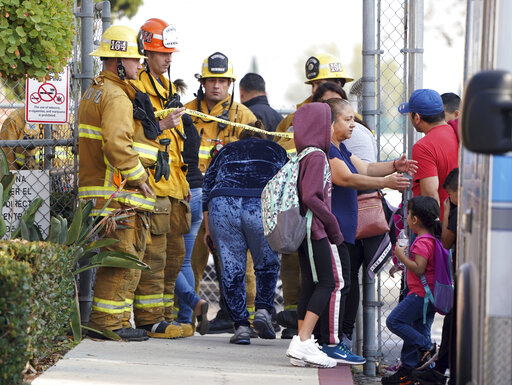CUDAHY, Calif. — Federal authorities will investigate why an airliner with engine trouble dumped jet fuel over a densely populated area of Southern California while making an emergency return to the airport, dousing dozens of schoolchildren in a smelly vapor.
Delta Air Lines Flight 89 to Shanghai, with 181 passengers and crew on board, turned back to Los Angeles International Airport only minutes after taking off Tuesday.
The pilot reported a compressor stall in the right engine — damage to a jet turbine that can occur through malfunction or when a foreign object such as a bird hits an engine. The damage can reduce engine thrust or, in worst cases, lead to a fire. Planes can take off weighted down for their journey, but if they must land early because of an emergency, it can be necessary to dump fuel so that the aircraft is lighter to avoid damage.
Air traffic control asked the aircrew if they wanted to return to LAX immediately or remain over the ocean “to hold and burn fuel,” according to a recording of the radio communications.
“We’re going to go ahead,” the pilot or co-pilot responds. “We’ve got it back under control. … We’re not critical.”
“OK, so you don’t need to hold or dump fuel or anything like that?” the controller asks.
“Ah, negative,” the pilot responds.
But the plane did later dump fuel, possibly while preparing to make a final turn before descending.
The fuel sprayed out of the plane in two lines and descended at midday in the city of Cudahy and nearby parts of Los Angeles County, about 13 miles (21 kilometers) east of the airport. It fell on five elementary schools, officials said.
The fuel, described by fire officials as a vapor, caused minor skin and lung irritation to 56 children and adults but nobody was taken to the hospital and the only decontamination required was soap and water, officials said.
Diego Martinez, a sixth-grader at Park Avenue Elementary in Cuday, said he and his classmates were outside for physical education class when they saw the airplane flying low overhead.
“It was very close,” he said.
Shortly afterward, the air filled with the pungent odor of fuel.
“It was very strong, the odor,” the 12-year-old said.
Diego wasn’t doused but some of his friends complained that their skin was itching.
Some teachers at Park Avenue had headaches from the smell, said Antonio Buenabad, area representative for the United Teachers Los Angeles union.
“They were anxious to get home and shower because the stench was very strong,” he said of the teachers.
Delta Air Lines said the aircraft landed safely after releasing fuel, “which was required as part of normal procedure to reach a safe landing weight.”
The internet was quickly clogged with people questioning the decision and suggesting that the pilot could have shut down the engine, retained the fuel and landed with one working engine at some risk of damage to the plane.
The Federal Aviation Administration said it is investigating.
“There are special fuel-dumping procedures for aircraft operating into and out of any major U.S. airport,” the FAA said in a statement. “These procedures call for fuel to be dumped over designated unpopulated areas, typically at higher altitudes so the fuel atomizes and disperses before it reaches the ground.”
However, pilots can deviate from the rules in an emergency for safety reasons, said Doug Moss, a retired airline captain and owner of AeroPacific Consulting, LLC, an aviation consulting firm based in Reno, Nevada.
The pilot could have stayed over the ocean to dump his fuel but that could have taken a half-hour up to an hour, Moss said.
Moss said when there is a compressor stall, the crew can’t determine how much damage was done internally to the engine.
“The fan blades may have separated and cut into the fuel lines, leaving an uncontrollable fire as a future possibility,” Moss said.
“He’s flying an airplane with a damaged engine that may be on fire,” Moss said. “So he has to make the decision: Do I spend the time to dump fuel or do I put this thing on the ground as soon as I can? You’re not going to kill anyone by dumping fuel.”
“There’s no dereliction of duty. Everybody’s trying to do the best they can but it’s a fast-paced, dynamic ballgame and there’s not a lot of time to think … lives are at stake,” Moss said. “He got it on the ground safely. Unfortunately, there was collateral damage. People got gas poured over them.”
Cornell said 31 children and adults were affected by the fuel dump at Park Avenue school and another 12 at 93rd Street Elementary school. The rest of those affected were at other schools.
About the photo: Firefighters allow parents into Park Avenue Elementary School where multiple people were treated for jet fuel exposure in Cudahy, Calif., on Tuesday. A jet returning to LAX dumped its fuel over the neighborhood and the school. Affected people at the school were treated for skin and eye irritation. No patients were transported to hospitals. (Scott Varley/The Orange County Register via AP)
Was this article valuable?
Here are more articles you may enjoy.


 The Return Period for An LA Wildfire-Scale Event May Be Shorter Than You Think
The Return Period for An LA Wildfire-Scale Event May Be Shorter Than You Think  Musk’s X Probed by UK Over Grok’s Thousands of Sexualized Images
Musk’s X Probed by UK Over Grok’s Thousands of Sexualized Images  Storm Goretti Batters Europe With Violent Winds, Power Cuts
Storm Goretti Batters Europe With Violent Winds, Power Cuts  First Brands Judge Approves Examiner to Probe Fraud Allegations
First Brands Judge Approves Examiner to Probe Fraud Allegations 